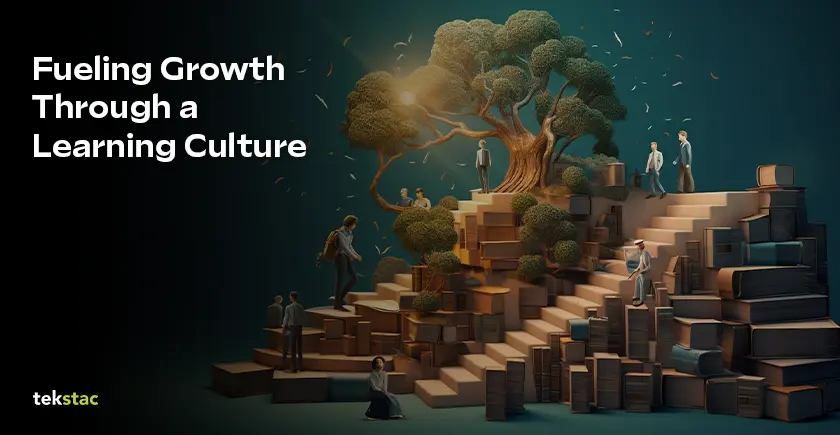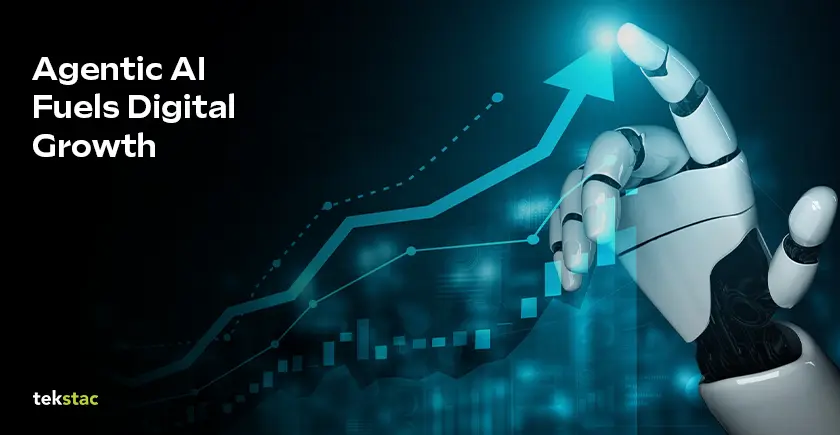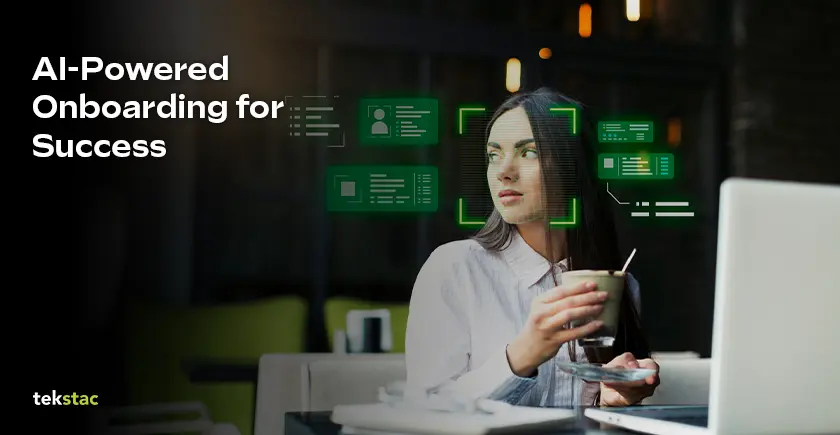AI-Powered Learning Culture Strategies to Inspire Continuous Growth
What makes employees stay, grow, and contribute their best? It’s not just a paycheck or job security, it’s the opportunity to learn and evolve. A strong, AI-powered learning culture gives people the tools to upskill, adapt, and drive business success through continuous, data-driven development.
The LinkedIn Workplace Learning Report 2025 reveals that companies investing in personalized, AI-powered L&D see higher engagement and retention. Employees now seek personalized workplace learning experiences that blend seamlessly into daily workflows rather than isolated training sessions. When organizations build a learning culture into their DNA, they don’t just build a skilled workforce, they build a future-ready business.
What Is a Learning Culture and Why Does It Matter?
A learning culture is not just about conducting training sessions; it’s about embedding learning into everyday work processes. A learning culture involves:
- Supporting individual learning and applying knowledge in real business scenarios
- Encouraging team learning and collective problem-solving
- Promoting knowledge sharing and continuous improvement at the organizational level
A strong, continuous learning culture powered by AI ensures employees are empowered to develop critical skills, innovate faster, and adapt to constant change. But the challenge lies in how to embed this culture into the organization’s DNA through effective workplace learning strategies.
What Are the Common Barriers to Building a Learning Culture (and How to Overcome Them)?
Many organizations struggle to establish a learning culture due to several key barriers, especially when training and development is not integrated with day-to-day work.
1. Lack of Leadership Support
76% of L&D professionals report that management does not prioritize learning. Leaders must set the tone by actively participating in and advocating for employee development.
2. Rigid Organizational Structures
Formal hierarchies and bureaucracies can make learning difficult. Employees may feel that learning takes them away from their core responsibilities. To counter this, organizations should embed adaptive learning for workforce upskilling directly into daily workflows, supported by intelligent learning platforms.
3. Inconsistent Learning Approaches
Some companies focus solely on formal training while neglecting informal, social, and digital learning. A mix of learning methods, such as mentorship programs, peer learning, and digital learning platforms—can enhance engagement.
4. Fear of Failure
Employees are often hesitant to experiment and take risks in learning due to fear of negative consequences. Encouraging a growth mindset and normalizing failure as a part of the learning process is essential.
3 Proven Strategies to Build a Strong Learning Culture
To develop a successful learning culture, organizations must take a systemic approach, integrating learning at three levels:
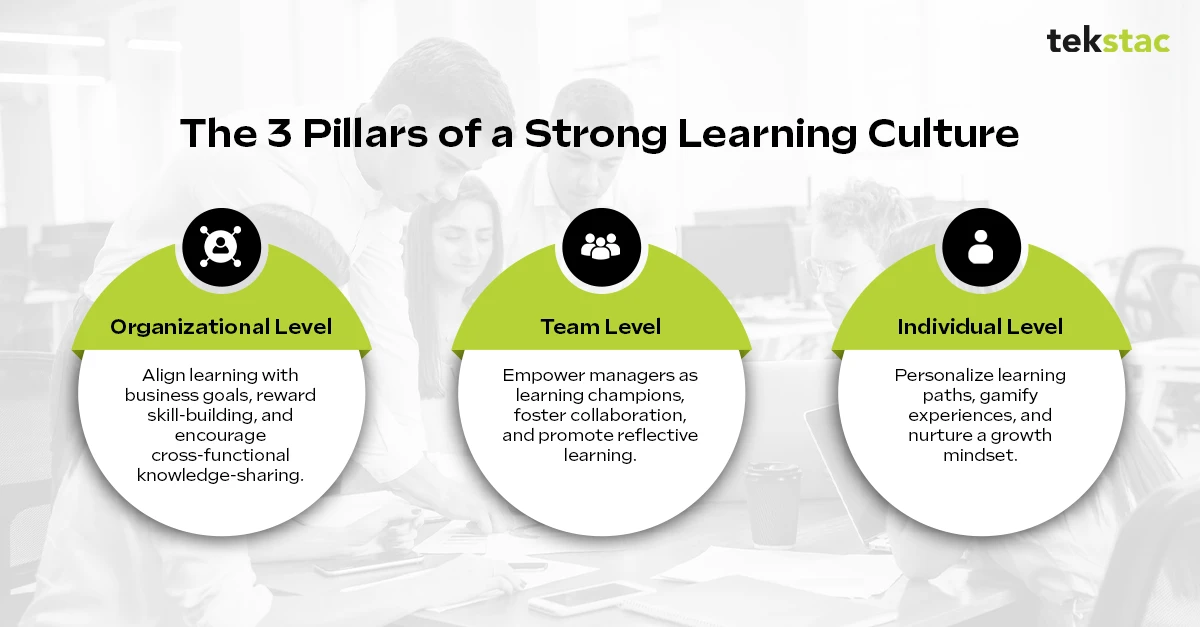
1. Organizational-Level Strategies
- Define and Communicate a Vision for Learning
- Leadership should clearly articulate how continuous learning aligns with business goals.
- For example, Google’s “20% time” policy allows employees to dedicate part of their workweek to learning and innovation.
- Develop Knowledge Management Systems
- Use AI-powered platforms to capture and share employee expertise.
- Encourage internal wikis, discussion forums, and collaboration tools for knowledge sharing.
- Build Learning into Performance Metrics
- Reward employees for mentorship, skill-building, and knowledge-sharing contributions.
- Link learning initiatives to promotion and performance reviews.
- Encourage Cross-Functional Learning
- Rotational programs and job shadowing opportunities can help employees gain a broader understanding of different business areas.
2. Team-Level Strategies
- Empower Managers as Learning Champions
- Equip managers with L&D training so they can support their teams effectively.
- Encourage managers to lead by example, demonstrating continuous learning in their own work.
- Foster Collaborative Learning
- Encourage team-based learning activities, such as hackathons, brainstorming sessions, and cross-team knowledge-sharing.
- Recognize and reward teams that innovate and solve problems collectively.
- Encourage Reflective Learning
- Implement “learning debriefs” after major projects to discuss what worked, what didn’t, and key takeaways.
- Introduce peer coaching and regular feedback sessions.
3. Individual-Level Strategies
- Personalized Learning Paths
- Offer customized learning plans based on individual career goals and skill gaps.
- Provide access to self-paced online courses, podcasts, and bite-sized learning modules.
- Leverage Gamification and AI
- Gamify learning by introducing leaderboards, challenges, and rewards.
- Use AI-powered tools to recommend relevant courses based on employees’ learning history and career progression.
- Promote a Growth Mindset
- Foster a culture of psychological safety where employees feel comfortable asking questions, experimenting, and making mistakes.
- Celebrate learning milestones and small wins.
Why AI-Powered Personalized Learning Drives Real Impact
Not all learning is equal. Your brain naturally pays more attention when something feels relevant and rewarding. That’s why personalized learning isn’t just a trend, it’s the key to making training actually work. A strong learning culture ensures employees are continuously engaged, motivated, and developing skills that matter.
Companies that get this right don’t rely on outdated, one-size-fits-all training. They use AI and VR to make learning interactive and tailored to each person.
- Your brain is wired for relevance – When learning connects to real goals, retention and engagement soar.
- Learning by Doing Beats Passive Training – Interactive experiences, real-world problem-solving, and hands-on practice help people absorb knowledge faster and apply it with confidence.
- Continuous Learning Keeps People Invested – When learning is a natural part of work, not just another training session, employees stay engaged and committed to their growth.
Companies with a strong learning culture experience 30–50% higher retention rates. Employees are more likely to stay in organizations that invest in their growth.
According to a study by Emerald Works, businesses with a mature learning culture see:
- 10% greater revenue growth
- 12% higher innovation rates
Future Trends in L&D: AI, VR, and Continuous Learning
1. AI & Machine Learning in L&D
- Adaptive learning platforms will personalize training content.
- AI-driven analytics will measure learning effectiveness.
2. Virtual Reality (VR) & Augmented Reality (AR)
- Companies will use VR simulations for real-world skill application.
- AR-enhanced onboarding programs will provide immersive learning experiences.
3. Microlearning & Just-in-Time Learning
- Employees prefer short, engaging learning modules that fit into their busy schedules.
- Mobile-based microlearning will become the norm.
4. Focus on Soft Skills Development
- With automation taking over routine tasks, emotional intelligence, adaptability, and critical thinking will be crucial skills in the future workplace.
Building a Strong Learning Culture with AI: The Tekstac Approach
A learning culture is not built overnight—it requires a strategic, long-term commitment from leaders, teams, and individuals. By embedding learning into everyday work, providing multiple learning opportunities, and aligning L&D with business objectives, organizations can unlock the full potential of their workforce.
Investing in learning today means building a workforce that is engaged, skilled, and ready for the future—especially when guided by the latest Learning and Development Trends shaping talent strategies globally. With Tekstac, learning isn’t just another checkbox—it becomes a part of everyday growth. Give your employees the tools to succeed, innovate, and thrive.
Transform the way your employees learn and grow with Tekstac Our cutting-edge platform offers AI-powered personalized learning, hands-on practice labs, and gamified learning to drive engagement and skill development.
Experience the Future of Learning & Development Today!
FAQs on Learning Culture
1. What are the 6 steps to creating a culture of learning?
Define a learning vision, enable leadership support, integrate AI tools, encourage collaboration, personalize learning paths, and reward continuous skill growth organization-wide.
2. How can AI help build a learning culture?
AI personalizes learning paths, recommends relevant content, tracks progress, and enables adaptive, continuous upskilling aligned with business goals and employee performance.
3. Why is a learning culture important for retention?
Employees stay longer when learning is continuous, personalized, and rewarding—it boosts engagement, growth opportunities, and trust in organizational development.
4. How can Tekstac help build a learning culture?
Tekstac uses AI-powered personalization, gamified learning, and hands-on labs to embed continuous learning into workflows, improving engagement, skills, and retention.
From Hype to Impact: Making AI Work for Your Business
Based on the McKinsey report “Superagency in the Workplace – Empowering People to Unlock AI’s Full Potential”
AI Work Begins Now: Are You Ready?
Artificial Intelligence (AI) is no longer a futuristic vision, it is here, reshaping industries at an unprecedented pace. Much like the steam engine revolutionized production during the Industrial Revolution, AI has the potential to redefine work, productivity, and economic growth. However, despite 92% of organizations planning to increase AI investments over the next three years, only 1% consider themselves AI-mature.
The key roadblock? Leadership readiness.
Organizations must move beyond small-scale AI initiatives and embrace bold AI-driven transformations to maintain a competitive edge.
AI: A Workplace Game Changer
AI is no longer just about automation; it is enabling smarter decision-making, problem-solving, and operational efficiency across industries. Generative AI alone is projected to generate $4.4 trillion in productivity gains. Yet, despite these promising numbers, many companies hesitate to move beyond the pilot phase of AI implementation.
Forward-thinking businesses understand that AI can:
- Enhance operational efficiency and decision-making.
- Improve customer experiences through personalized interactions.
- Drive innovation by identifying market trends and optimizing business strategies.
The question is not whether companies should adopt AI but how effectively they can deploy it at scale.
The Leadership Gap: Are Employees Ahead of the Curve?
One of the most striking findings of the MC Kinsey report is that employees are adopting AI faster than leaders anticipate:
- Three times more employees use AI in their daily tasks than executives estimate.
- 70% of employees believe AI will significantly alter at least 30% of their work within two years.
- Only 20% of leaders foresee AI transforming workflows in the near future.
This misalignment presents a major challenge. Employees are ready for AI-driven change, but leadership hesitancy is slowing progress. Organizations need to bridge this gap by educating leaders, fostering AI-friendly workplace cultures, and integrating AI into strategic planning.
A critical piece of this puzzle is investing in learning and skilling programs that empower both employees and leaders to understand, adapt to, and fully leverage AI technologies.
This is where platform like Tekstac play a pivotal role to integrates AI-driven personalized learning, assessments, and skill development into the workplace. By aligning learning paths with role-specific needs, Tekstac helps individuals and organizations build the AI fluency required to lead transformation, not just follow it.
Whether it’s through simulated assessments, AI-proctored environments, or performance dashboards, we ensures continuous upskilling aligned with evolving industry demands.
Speed vs. Safety: Navigating AI Risks
With AI adoption comes responsibility. Businesses must balance the rapid deployment of AI with concerns around cybersecurity, bias, and ethical decision-making.
Key concerns include:
- Cybersecurity risks –51% of employees cite security vulnerabilities as their top AI concern.
- AI bias and fairness – Organizations must ensure AI models are transparent and equitable.
- AI explainability – Businesses need AI systems that provide clear, logical justifications for their decisions.
To mitigate these risks, organizations should implement robust AI governance frameworks, establish ethical benchmarks, and ensure compliance with data privacy regulations.
Moving Beyond Incremental Change: The Need for Bold AI Ambitions
Many companies take a cautious approach to AI, experimenting with small-scale projects rather than fully embedding AI into their core operations. However, true transformation requires bold AI ambitions. Industries such as healthcare, finance, and retail are already seeing the benefits of large-scale AI integration:
- Healthcare – AI-driven drug discovery and personalized treatment plans.
- Finance – AI-powered fraud detection and predictive analytics.
- Retail – AI-driven demand forecasting and customer insights.
Organizations that continue treating AI as an auxiliary tool rather than a fundamental part of their business model risk falling behind.
The Real Challenge: Organizational Readiness, Not Technology
Despite the rapid advancement of AI technology, organizations face several operational challenges when it comes to AI adoption. The report highlights five major hurdles:
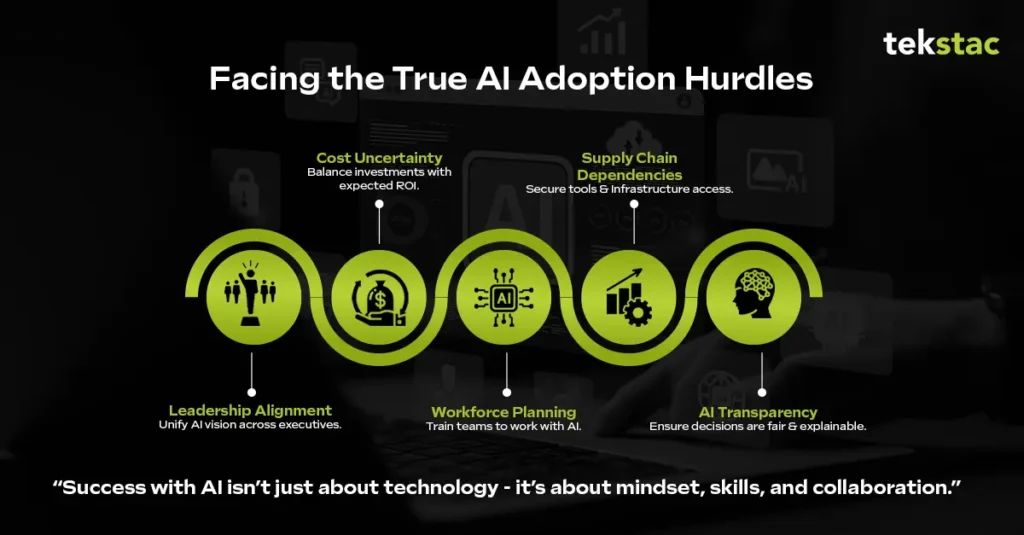
- Leadership alignment – Executives must develop a unified AI vision.
- Cost uncertainty – AI investments should be balanced with long-term ROI expectations.
- Workforce planning – Employees must be trained to work alongside AI rather than fear job displacement.
- Supply chain dependencies – Businesses need access to the right AI tools and infrastructure.
- AI transparency – AI-driven decisions must be understandable and unbiased.
Overcoming these challenges requires strategic planning, cross-functional collaboration, and a commitment to continuous learning and adaptation.
Here are the critical takeaways from McKinsey’s findings:
Leadership inertia is the bottleneck
While 92% of companies plan to increase AI investments, only 1% consider themselves AI-mature—largely because leadership hasn’t aligned on bold, long-term AI strategies.
Employees are ahead of the curve
There’s a striking mismatch between executive perception and employee reality: three times more employees are using AI than leaders estimate, and 70% expect AI to significantly reshape their work within two years.
Ethical and secure AI is non-negotiable
As organizations scale AI, concerns around cybersecurity, data privacy, and algorithmic bias must be actively addressed. AI governance, explainability, and fairness should be foundational—not afterthoughts.
Small pilots are not enough
To unlock transformative value, businesses must move beyond incremental efforts and fully embed AI into their core workflows, products, and services.
Skilling is a strategic lever
Organizational capability depends on a well-trained, AI-literate workforce that includes both frontline employees and C-suite leaders.
Conclusion: The Road to AI Maturity
AI presents limitless opportunities, but only organizations that act decisively will unlock its full potential. Leaders must step up, align AI strategies with business objectives, and foster AI-literate workplaces.
To succeed in the AI-driven future, businesses must:
- Invest in AI training for employees and leadership alike.
- Implement ethical AI governance to ensure responsible AI use.
- Scale AI adoption beyond experimental phases to drive tangible business impact.
- Embrace bold AI ambitions that transform workflows and create new opportunities.
AI is no longer optional; it is an imperative. The time to act is now. Organizations that leverage AI strategically will not only stay competitive but also redefine the future of work.
What Is a Talent Marketplace? Benefits, Examples, and Implementation for 2026
What Is the New Age of Talent Management with Marketplaces?
Imagine a workplace where employees aren’t restricted to their job titles but can explore opportunities that align with their passions, skills, and career aspirations. What if your organization could tap into hidden talent, boost productivity, and reduce turnover, all through a single AI-powered platform? A talent marketplace is more than an HR tool: it’s a skills-based workforce marketplace that drives career mobility, reskilling, and agility at scale.
In today’s competitive business landscape, companies need to be agile, ensuring that talent is utilized effectively, and employees remain engaged. A Talent Marketplace transforms traditional workforce management by connecting employees with the right internal opportunities, whether it’s a new project, mentorship, skill-building course, or even a lateral career shift. This innovative approach not only enhances internal mobility but also future-proofs organizations by fostering continuous learning and professional growth.
So, what exactly is a Talent Marketplace, and how can it revolutionize your organization? Let’s dive in.
What Is a Talent Marketplace, and Why Does It Matter for Organizations Today?
A Talent Marketplace is a core component of the AI-powered talent intelligence ecosystem. Platforms like Tekstac leverage predictive analytics and machine learning to align employee skills, roles, and business goals — driving real-time workforce agility and internal mobility. These opportunities can include:
- New job roles
- Project-based work
- Mentorship programs
- Learning and development courses
- Gig or part-time assignments within the company
- Cross-functional collaborations
- Leadership development programs
Unlike traditional workforce planning, which follows a rigid hierarchical structure, a Talent Marketplace promotes a fluid, skills-based approach, allowing employees to move across teams, projects, and roles dynamically.
How Does a Talent Marketplace Actually Work in Practice?
Today, many Talent Marketplaces are powered by AI & data analytics to match employees’ skills, interests, and career aspirations with available opportunities. The system typically functions as follows:
- Employee Profile Creation: Employees create and update their profiles with skills, certifications, and interests.
- Opportunity Listings: Managers and HR teams post job openings, projects, and training programs.
- AI-Powered Matching: The platform suggests opportunities to employees based on their skills and aspirations.
- Self-Nomination: Employees can apply for opportunities that align with their career growth.
- Manager Recommendations: Managers can nominate employees for relevant roles and projects.
- Performance Tracking and Feedback: Managers and HR professionals monitor progress and provide insights to enhance employee development.
- Skill Gap Analysis: The platform identifies skill gaps and suggests relevant upskilling programs.
What Are the Key Features of a Modern Talent Marketplace Platform?
A well-designed Talent Marketplace should offer the following features:
1. AI-driven Recommendations
Personalized suggestions for roles, projects, and learning paths based on employees’ skills, goals, and aspirations.
2. Real-time Analytics
Live dashboards and insights help HR and managers track workforce trends, skill supply-demand gaps, and engagement metrics.
3. Employee-led Career Development
Empowers employees to own their growth journey by exploring and applying for internal opportunities that match their goals.
4. Integration with Learning Platforms
Seamlessly connects to internal or external learning systems, enabling targeted upskilling based on opportunity requirements.
5. Internal Gig Economy Support
Facilitates short-term assignments, projects, and side gigs within the organization, boosting agility and cross-functional exposure.
6. Transparent Performance Tracking
Enables clear visibility into employee contributions and outcomes, helping guide development and recognition decisions.
What Are the Top Benefits of a Talent Marketplace for Organizations?
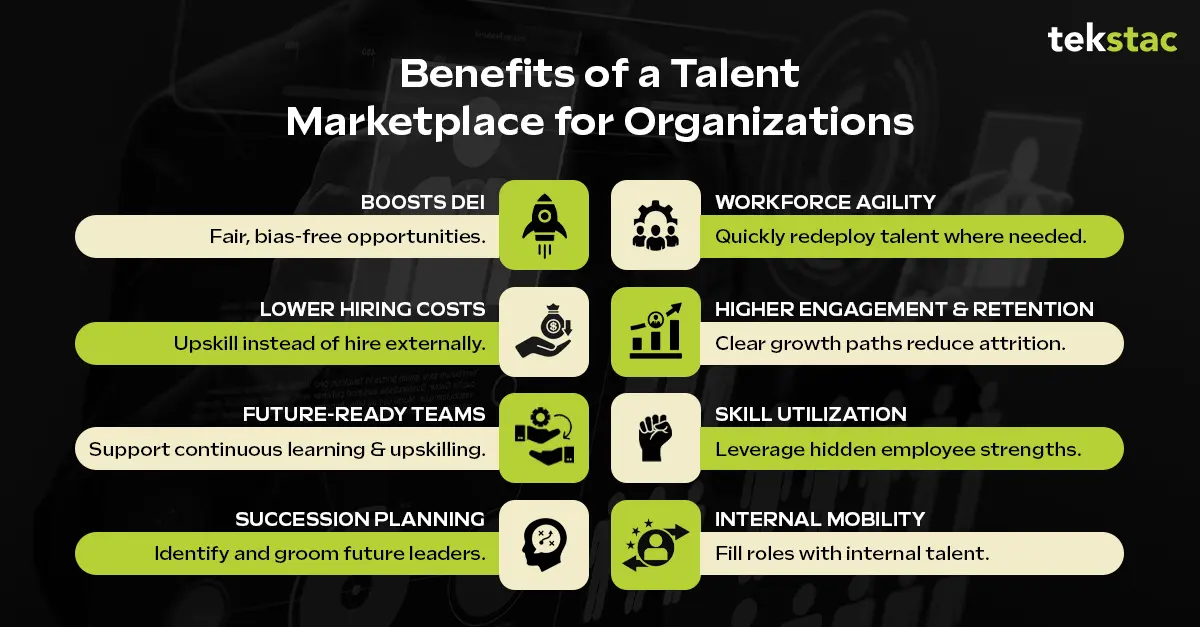
1. Improved Workforce Agility
A Talent Marketplace enables organizations to quickly redeploy talent where it is most needed. Whether it’s filling urgent project gaps or responding to market shifts, this platform ensures that employees are effectively utilized.
2. Enhanced Employee Engagement and Retention
When employees see clear career growth opportunities within the organization, they are more likely to stay engaged. A Talent Marketplace helps in creating a transparent career path, reducing attrition rates significantly. According to Gartner, companies using talent intelligence platforms report a 30% increase in internal mobility and 25% lower hiring costs.
3. Better Skill Utilization and Development
Many organizations underutilize employee skills due to a lack of visibility. A Talent Marketplace provides a structured way to identify and leverage hidden talents, ensuring employees work in areas that align with their strengths.
4. Encourages Internal Mobility
Instead of looking externally to fill roles, organizations can focus on internal talent mobility. Employees can transition between departments and roles, leading to a more flexible workforce and reducing hiring costs.
5. Diversity, Equity, and Inclusion (DEI) Improvement
A Talent Marketplace promotes fair access to opportunities by removing biases in hiring and promotions. AI-driven recommendations ensure employees are matched based on skills rather than personal connections or subjective criteria.
6. Reduces Hiring Costs and Time
Finding external talent is expensive and time-consuming. With a Talent Marketplace, organizations can identify and upskill existing employees, reducing dependency on external hiring.
7. Future-Proofs the Workforce
With technology and industry trends evolving rapidly, organizations must ensure their workforce remains future-ready. A Talent Marketplace fosters continuous learning and upskilling, allowing employees to adapt to new roles and responsibilities seamlessly.
8. Strengthens Succession Planning
By analyzing internal talent, organizations can identify high-potential employees and groom them for leadership roles, ensuring business continuity.
What Are Some Real-World Examples of Talent Marketplaces in Action?
1. Unilever
Unilever adopted an AI-driven talent marketplace to enhance internal mobility and reskilling initiatives. The platform enabled employees to take on short-term assignments, upskill, and explore new career paths within the company, leading to increased engagement and retention.
2. Schneider Electric
Schneider Electric used a Talent Marketplace to match employees with projects and training programs. This resulted in better workforce agility and a significant reduction in recruitment costs.
3. Nestlé
Nestlé implemented an AI-driven Talent Marketplace that provided employees with clear internal growth opportunities while also launching an internal gig marketplace. This empowered employees to take on cross-functional projects, which not only improved satisfaction and retention but also reduced external hiring costs.
Growing adoption in India and Singapore as organizations prioritize digital reskilling and AI readiness.
How Can You Implement a Talent Marketplace in Your Organization?
To successfully implement a Talent Marketplace, consider these key steps:
1. Select the Right Platform
There are various Talent Marketplace solutions available, such as Gloat, Eightfold AI, and Workday Talent Marketplace. Choose one that aligns with your organization’s goals and infrastructure.
2. Encourage Employee Participation
A Talent Marketplace thrives when employees actively engage. Organizations should promote awareness through training sessions and leadership support.
3. Integrate with Learning and Development
Ensure that your Talent Marketplace is linked with learning platforms so employees can upskill based on career opportunities available within the system.
4. Foster a Culture of Internal Mobility
Encourage managers to embrace a skills-based approach and support employees in moving across teams and departments.
5. Leverage Data and AI for Optimization
Regularly analyze data from the Talent Marketplace to refine matching algorithms, improve employee experience, and optimize workforce planning.
What Future Trends Will Shape Talent Marketplaces in 2026 and Beyond?
As AI and automation continue to shape the workplace, Talent Marketplaces will become even more sophisticated. Future trends may include:
- AI-driven career coaching to provide employees with personalized career paths.
- Enhanced gig work models for increased flexibility.
- Predictive analytics to anticipate skill shortages and workforce needs.
- Increased integration with external learning platforms for lifelong learning.
Why Are Talent Marketplaces the Key to Workforce Agility and Mobility?
A Talent Marketplace is a game-changer for organizations aiming to boost agility, employee engagement, and internal mobility. By leveraging AI-powered internal talent solutions, businesses can create a future-ready workforce, maximize skill utilization, and enhance employee satisfaction. Investing in a Talent Marketplace today will drive long-term success for both employees and the organization.
At Tekstac, we empower organizations to adopt a skills-first approach by enabling seamless talent discovery, role fitment, and growth mapping. Our intelligent platform supports internal mobility, continuous learning, and AI-powered recommendations—making your workforce future-ready.
Are you ready to unlock the full potential of your workforce? An enterprise talent marketplace platform can transform your talent strategy, drive workforce agility, and prepare your people for the future of work. By embracing a skills-based career marketplace, organizations can reduce costs, improve retention, and ensure they remain future-ready.
FAQs on Talent Marketplaces
1. How do I access a Talent Marketplace?
Employees can access their organization’s Talent Marketplace through an internal HR portal or platform like Tekstac to explore roles, gigs, and learning paths.
2. How does a Talent Marketplace benefit employees?
It helps employees discover new roles, projects, and upskilling opportunities, fostering career growth and internal mobility.
3. What is a Talent Experience Platform?
A Talent Experience Platform integrates learning, performance, and internal mobility tools to deliver personalized, AI-driven career journeys for employees.
4. What is the future of Talent Marketplaces?
Talent Marketplaces will evolve with AI, predictive analytics, and skills intelligence—enabling continuous learning, agile workforce deployment, and future-ready organizations.
Agentic AI Explained: What It Is and How It’s Transforming Business Processes
Based on PwC India’s Report on “Powering Automation with Agents”
The Rise of Agentic AI and Why It’s Transforming Modern Businesses
Automation has come a long way- from simple task automation to AI-driven intelligent systems. Now, we are entering a new era: Agentic Powered Automation (APA), a revolutionary approach that combines Generative AI (GenAI) with automation tools to create self-learning, adaptive business processes. A recent report by PwC India sheds light on how APA is reshaping industries, enhancing efficiency, and paving the way for a smarter, AI-driven future.
What Is Agentic Powered Automation (APA) and How It Works
At its core, APA integrates AI-powered agents (the ‘brain’) with intelligent automation tools (the ‘hands’) to create dynamic, responsive business workflows. These AI agents don’t just follow predefined rules, they understand context, make decisions, and collaborate with other agents to execute complex tasks with minimal human intervention.
This shift from traditional automation to AI-driven decision-making marks a significant transformation in how businesses operate. Instead of static workflows, APA enables real-time adaptability, making businesses more resilient and efficient.
How Intelligent Agents Drive Enterprise Transformation
Agentic automation is rapidly being adopted across industries. The PwC report highlights several key areas where APA is making a significant impact:

Real-World Agentic AI Use Cases Across Key Industries
1. Finance & Accounting
- Automated invoice processing to reduce human errors and increase efficiency.
- AI-powered cash flow management, providing real-time insights for financial planning.
- Smart expense reconciliation to streamline approvals and detect discrepancies.
2. Supply Chain & Logistics
- Demand forecasting agents analyze historical trends to improve inventory management.
- Supplier onboarding automation simplifies contract verification and reduces processing time.
- Returns processing automation ensures faster refunds and seamless restocking.
3. Human Resources & Talent Acquisition
- AI-driven talent search agents source, screen, and shortlist candidates efficiently.
- Employee experience bots provide instant responses to HR-related queries.
- Automated compliance and payroll management ensures accuracy and efficiency.
4. Customer Service & Marketing
- Conversational AI agents provide personalized customer support 24/7.
- Brand monitoring tools track customer sentiment and flag potential risks.
- SEO optimization agents analyze website performance and suggest improvements.
These examples illustrate how APA is enhancing business operations by reducing manual intervention, minimizing errors, and accelerating decision-making processes.
📊 Industry Adoption Snapshot (PwC Survey Data)
A recent PwC Digital Commerce Survey shows that Agentic AI adoption is rapidly accelerating across enterprises:
- 79% of organizations are already using AI agents in some capacity.
- 66% of adopters report measurable business value, especially in productivity, cost reduction, and decision-making.
These numbers highlight that Agentic AI is no longer experimental—it is actively driving business outcomes across finance, HR, supply chain, customer service, and operations.
How Agentic AI Augments Human Work Instead of Replacing It
One of the biggest concerns surrounding automation is job displacement. However, APA does not aim to replace human workers; rather, it empowers them by taking over repetitive, time-consuming tasks. This allows professionals to focus on more strategic, creative, and decision-making roles.
For instance:
Financial analysts can leverage AI-generated insights to make more informed investment decisions.
- HR professionals can focus on talent development rather than spending time on administrative tasks.
- Marketing teams can use AI-driven analytics to craft more targeted and effective campaigns.
Thus, APA fosters a symbiotic relationship between humans and AI, where technology amplifies human capabilities instead of replacing them.
Key Challenges and Ethical Risks of Adopting Agentic AI
With great power comes great responsibility. As organizations integrate APA into their ecosystems, they must address key challenges:
- Ethical AI Governance – Ensuring AI agents make fair and unbiased decisions.
- Data Privacy & Security – Protecting sensitive information from misuse.
- Transparency & Accountability – Keeping AI operations interpretable and auditable.
- Regulatory Compliance – Aligning automation strategies with global and local laws.
Companies must establish clear AI governance frameworks to mitigate risks and build trust among employees, customers, and stakeholders.
The Future of Agentic AI and Autonomous Automation
PwC’s report highlights that the future of business lies in seamlessly blending human expertise with AI-powered automation. Organizations that adopt APA today will gain a competitive edge by:
- Accelerating productivity through smart automation.
- Reducing operational costs with minimal human intervention.
- Enhancing customer and employee experiences through intelligent interactions.
As the world moves toward an AI-driven future, embracing APA is no longer an option, it’s a necessity. Businesses that integrate AI-driven agents into their workflows will unlock new growth opportunities, drive efficiency, and reshape industries for years to come.
Final Thoughts: Why Agentic AI Is Now a Business Imperative
Agentic Powered Automation is more than just a technological advancement; it’s a paradigm shift in how businesses operate. As organizations prepare for this transformation, they must adopt AI responsibly, ensuring that technology serves as an enabler of human potential rather than a replacement.
The question is no longer whether businesses should embrace Agentic Powered Automation (APA) but how quickly they can adapt to stay ahead in an increasingly competitive landscape. The future of work is here, are we ready to embrace it?
Agentic AI FAQs
1. How does Agentic AI differ from traditional automation?
Traditional automation follows predefined rules, while Agentic AI adapts in real time, understands context, and makes autonomous decisions.
2. What are the top business use cases of Agentic AI?
Finance automation, supply chain optimization, HR workflows, talent acquisition, customer support, marketing automation, and compliance.
3. Will Agentic AI replace human jobs?
No. Agentic AI automates repetitive tasks while enabling humans to focus on strategic, creative, and leadership roles.
4. Why should enterprises adopt Agentic AI now?
It increases efficiency, reduces costs, accelerates decision-making, and helps businesses stay competitive in an AI-first economy.
Why Every HR Team Needs AI-Powered Onboarding in 2026
What Makes This a New Era for AI-Powered Onboarding?
A new employee walks through the virtual doors of an organization, greeted not by piles of paperwork but by an intelligent assistant that knows their role, preferences, and needs. This is not a scene from the future; it’s the power of AI-powered onboarding, reshaping first impressions and setting new standards for employee integration.
Why Is Onboarding So Important in the Age of AI?
Onboarding is much more than just paperwork and introductions; it’s the foundation of a positive employee-employer relationship. According to Brandon Hall Group research, organizations with a robust onboarding process improve new hire retention by 82% and productivity by over 70%.
Despite this, a Gallup survey found that only 12% of employees strongly agree that their company does a great job onboarding new hires. This discrepancy highlights a major gap in traditional onboarding methods, which are often inconsistent and ineffective.
AI-powered onboarding addresses these challenges by streamlining processes, enhancing personalization, and ensuring consistency, all while reducing the burden on HR teams. Let’s explore how this innovative approach is reshaping the onboarding landscape.
5 Key Benefits of AI-Powered Onboarding
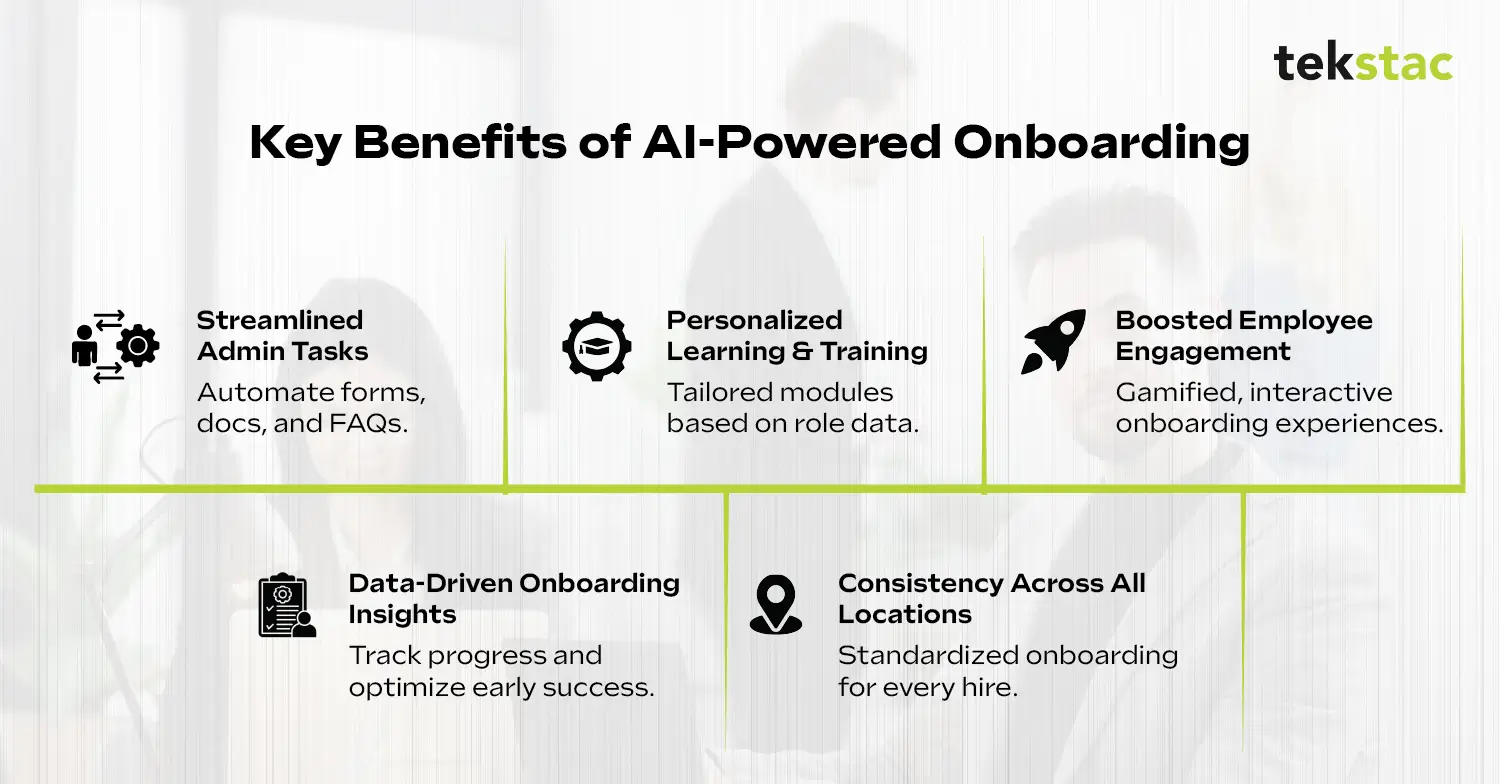
1. Streamlined Administrative Tasks
One of the significant advantages of AI in onboarding is its ability to automate repetitive administrative tasks. From generating offer letters to collecting required documents, AI-powered tools can handle these processes efficiently, allowing HR professionals to focus on more strategic aspects of onboarding.
For instance, AI chatbots can guide new hires through document submissions, answer frequently asked questions, and provide real-time support. This streamlines the process while ensuring all critical steps are consistently followed. A report from Aberdeen Group found that best-in-class onboarding processes, often backed by automation, improve employee engagement by 54%.
2. Personalized Learning and Training
Every employee has unique needs, learning styles, and learns at a different pace. AI-powered onboarding platforms use data analytics to tailor training programs to individual requirements. By analyzing an employee’s role, skills, and prior experience, these systems can recommend specific learning modules, courses, and resources.
Personalized onboarding ensures that employees receive relevant training, helping them acquire the skills needed for their roles faster. Moreover, it fosters a sense of belonging by demonstrating the company’s commitment to their growth. According to LinkedIn’s 2022 Workplace Learning Report, 94% of employees say they would stay at a company longer if it invested in their learning and development.
3. Improved Employee Engagement
AI-powered tools can create interactive and engaging onboarding experiences. Virtual reality (VR) tours, gamified learning modules, and AI-driven simulations make the process more enjoyable and memorable. For example, a new hire could participate in a virtual tour of the office or complete a gamified challenge that introduces them to company policies.
Such initiatives not only make onboarding more engaging but also leave a lasting impression, helping new employees feel connected to the organization from the start.
4. Data-Driven Insights
AI-powered platforms provide HR teams with valuable insights into the onboarding process. By tracking metrics such as training completion rates, employee feedback, and time-to-productivity, organizations can identify areas for improvement and make data-driven decisions.
These insights also enable proactive interventions. For example, if a new hire is struggling with a particular training module, the system can alert HR or suggest alternative resources to address the challenge. A report by the Harvard Business Review highlights that organizations leveraging data-driven onboarding processes can reduce employee turnover by up to 50%.
5. Consistency Across Locations
For organizations with multiple offices or remote teams, maintaining consistency in onboarding can be challenging. AI-powered platforms ensure that every new hire, regardless of location, receives a standardized and high-quality onboarding experience. Automated workflows and digital tools make it easy to replicate successful onboarding practices across different settings.
How Are AI-Powered Tools Revolutionizing the Onboarding Process?
Several AI-powered tools and technologies are driving the transformation of onboarding processes. Here are some notable examples:
- Chatbots and Virtual Assistants: These tools provide instant support to new hires, answering questions, guiding them through processes, and ensuring timely task completion. According to Gartner, by 2025, 75% of HR inquiries will be handled by conversational AI chatbots.
- Learning Management Systems (LMS): AI-enhanced LMS platforms offer personalized learning paths, track progress, and provide interactive content tailored to individual roles. Companies using AI-powered LMS have reported a 60% increase in learning efficiency, according to Deloitte.
- Virtual Reality (VR): VR technology creates immersive onboarding experiences, such as virtual office tours or role-specific simulations, enhancing understanding and engagement. PwC research found that employees trained with VR were 4 times faster to complete training than in a traditional classroom setting.
- Natural Language Processing (NLP): NLP-powered tools analyze employee feedback and sentiment, helping HR teams identify potential concerns and improve the onboarding process. Studies show that AI-driven sentiment analysis can increase employee satisfaction scores by 30%.
Tekstac’s AI-powered platform builds on these innovations by automating and personalizing onboarding workflows end-to-end. Through intelligent automation and data-driven insights, Tekstac helps organizations deliver seamless, engaging, and efficient new hire experiences that accelerate productivity from day one.
Overcoming AI-Powered Onboarding Challenges
While AI-powered onboarding offers numerous benefits, it’s not without challenges. Organizations must address concerns related to data privacy, integration, and user adoption to fully realize its potential.
1. Data Privacy and Security
Handling sensitive employee data requires robust security measures. Organizations must ensure that AI-powered platforms comply with data protection regulations and implement encryption, access controls, and regular audits to safeguard information. According to IBM , the average cost of a data breach in 2023 was $4.45 million, making security a top priority.
2. Integration with Existing Systems
Seamless integration with existing HR and IT systems is crucial for the success of AI-powered onboarding. Companies should invest in scalable and compatible solutions that can work with their current infrastructure. Research from SHRM indicates that 60% of HR professionals struggle with technology integration issues, which can hinder onboarding success.
3. User Adoption
Introducing new technology can sometimes face resistance from employees and HR teams. Providing training and demonstrating the tangible benefits of AI-powered onboarding can help drive adoption and ease the transition. Studies show that organizations offering technology training experience a 40% higher adoption rate for new digital tools.
What Does the Future Hold for AI Onboarding?
As AI technology continues to evolve, the future of onboarding looks promising. Here are some trends to watch:
- Predictive Analytics: AI systems will predict employee needs and potential challenges, enabling HR teams to proactively address them.
- Hyper-Personalization: Advanced AI algorithms will deliver even more tailored experiences, considering factors such as cultural background, career goals, and personal preferences.
- Integration with Employee Lifecycle Management: AI-powered onboarding will seamlessly connect with other HR processes, such as performance management and career development, creating a cohesive employee experience.
Key Takeaways on AI-Powered Onboarding
AI-powered onboarding represents a paradigm shift in how organizations integrate new hires. By automating administrative tasks, personalizing learning experiences, and providing valuable insights, it enhances the efficiency and effectiveness of the onboarding process. While challenges exist, they are outweighed by the significant benefits that AI brings to the table.
As organizations strive to attract and retain top talent in an increasingly competitive landscape, embracing AI-powered onboarding is no longer a choice but a necessity.
Platforms like Tekstac are at the forefront of this transformation, offering comprehensive onboarding solutions that combine AI-driven content delivery, personalized learning paths, skill assessments, and intelligent reporting. Tekstac enables organizations to not only onboard with efficiency but also nurture long-term talent development from the very beginning.
FAQs on AI Onboarding
1. How does AI improve the onboarding experience?
AI tools automate repetitive tasks like document submission, training reminders, and feedback collection. They also personalize learning content and provide real-time support through chatbots, making the onboarding process smoother and more engaging.
2. Is AI-powered onboarding suitable for all organizations?
Yes. Whether a startup or enterprise, any organization can benefit from AI-powered onboarding tools to improve efficiency, reduce administrative burden, and create a consistent experience for new employees.
3. What is the best AI tool for scheduling?
AI scheduling tools like Clockwise, x.ai, and Calendly optimize meeting times, automate invites, and reduce conflicts, saving time for HR and employees.
4. What is contextual onboarding?
Contextual onboarding delivers role-specific guidance and resources at the right moment, helping new hires learn efficiently within their actual work environment.
5 Questions to Ask Before Investing in a Course Building Platform
What Is a Course Building Platform?
A Course Building Platform is a software solution that enables educators, enterprises, and trainers to design, deliver, and monetize online courses. These platforms often include interactive tools such as video integration, gamification, assessments, and analytics to enhance learner engagement and improve outcomes.
Why Choosing the Right Course Building Platform Matters?
Online learning is booming, with the global e-learning market projected to reach $457.8 billion by 2026 (Statista). Businesses, educators, and entrepreneurs are leveraging digital learning to expand their reach, enhance engagement, and boost revenue.
The right platform can enhance learner engagement, streamline content delivery, and boost revenue. However, with so many options available, choosing the right Course Building Platform is critical.
5 Questions to Ask Before Choosing a Course Building Platform
Tekstac, a leading AI-powered upskilling solution, offers a comprehensive Course Building Platform tailored to modern learning needs. Before making an investment, ask yourself these five key questions to ensure you select the best platform for your needs.
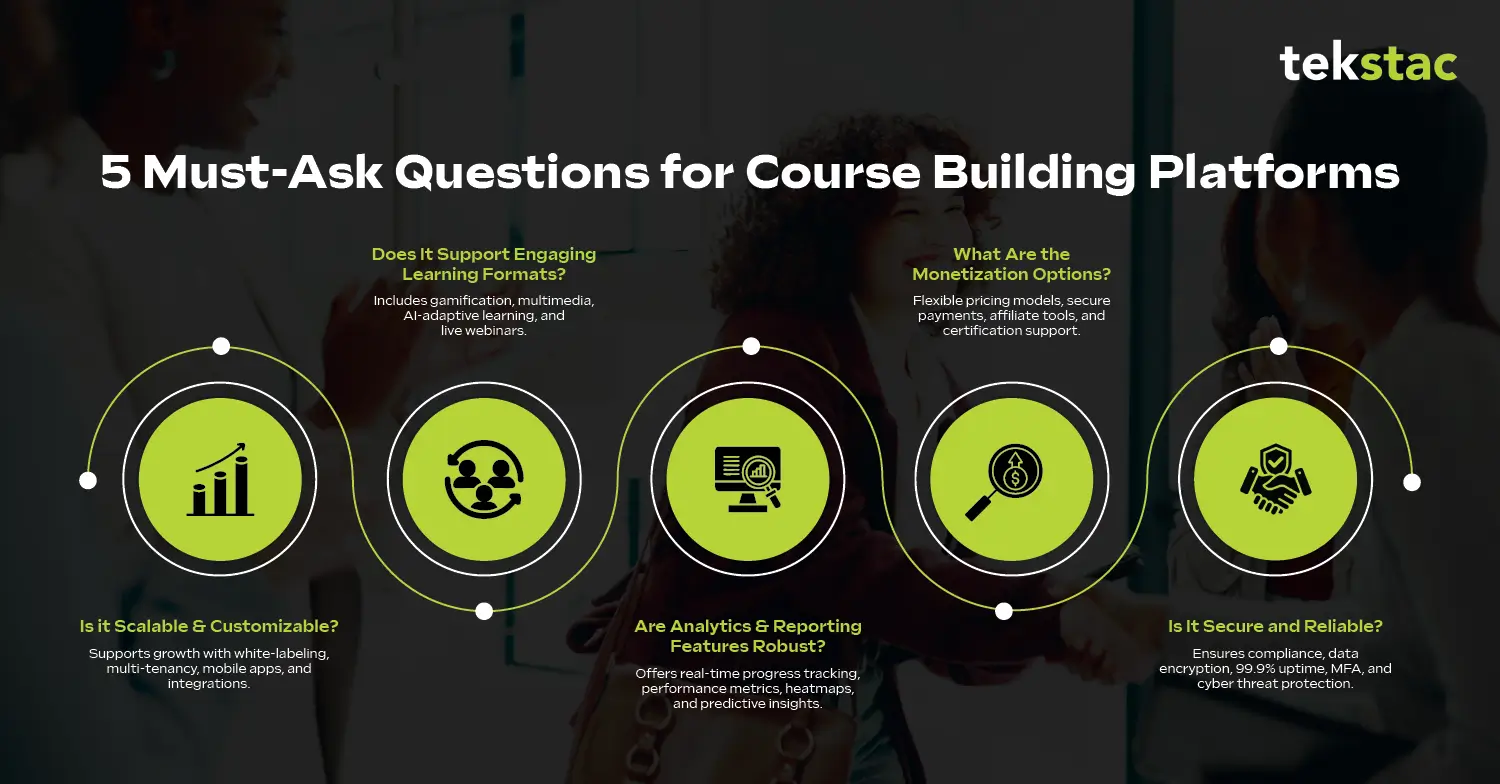
1. Does the Platform Offer Scalability and Customization?
As your business or educational program grows, your Course Building Platform should scale with you. A rigid platform can quickly become a bottleneck, limiting your ability to expand course offerings, accommodate a growing learner base, or integrate new technologies. To ensure long-term success, evaluate the following:
Customization Options
The ability to tailor branding, themes, course layouts, and user interfaces ensures your platform aligns with your brand identity and learning goals. Look for platforms that allow advanced customization, such as white-labeling, custom domain usage, and personalized dashboards for learners.
Scalability
A good platform should handle an increasing number of learners and courses without compromising performance. Check if the platform offers cloud-based infrastructure, load balancing, and automatic scaling to support growth.
Integration Capabilities
Seamless integration with Learning Management Systems (LMSs), Customer Relationship Management (CRM) software, and marketing automation tools can streamline operations. Platforms that support API access and integrations with tools like Zapier, HubSpot, and Salesforce offer added flexibility.
Multi-Tenancy Support
If you plan to offer courses to different groups, such as corporate clients, educational institutions, or internal teams, multi-tenancy support allows you to manage multiple learning environments under one system.
Mobile and Multi-Device Accessibility
With an increasing number of learners accessing content on mobile devices, a scalable platform should provide a responsive design and dedicated mobile applications.
A scalable platform allows for continuous growth without switching systems, which can be costly and disruptive. Future-proofing your investment ensures that your platform remains relevant and efficient as your needs evolve.
“A study found that 64% of organizations prioritize scalability when selecting an LMS or Course Building Platform”.
2. What Learning Formats and Engagement Tools Are Available?
Different learners engage with content in various ways, making diverse learning formats essential. The effectiveness of a Course Building Platform depends on how well it supports different learning styles. Look for a platform that includes:
Multimedia Content
The ability to incorporate video, audio, interactive quizzes, and infographics is crucial for engagement. Studies show that video-based learning increases retention rates by 25-60% compared to text-based content (Forrester Research).
Gamification Features
Incorporating elements such as badges, point systems, and leaderboards can significantly boost learner motivation and drive interaction. According to a recent report, such gamified strategies have the potential to elevate learner engagement by as much as 50%.
Community Engagement
Built-in discussion forums, live Q&As, and peer collaboration features create a sense of community and encourage knowledge sharing.
AI-Powered Adaptive Learning
AI-driven platforms personalize course content based on individual learner progress, improving retention and learning outcomes.
Live Learning & Webinars
The ability to conduct live classes or one-on-one sessions via Zoom or Microsoft Teams integration adds flexibility and real-time interaction.
Engagement tools enhance the learning experience, ensuring students stay motivated and complete their courses successfully.
“According to a LinkedIn Learning Report, 94% of employees say they would stay longer at a company if it invested in their learning and development, highlighting the importance of engaging learning tools”.
3. Does It Offer Robust Analytics and Reporting?
Data-driven insights are key to improving course effectiveness and learner outcomes. A well-designed Course Building Platform should provide:
Learner Progress Tracking
Monitor course completion rates, quiz scores, and time spent on modules to identify engagement patterns and areas for improvement. Detailed tracking helps instructors intervene early if learners struggle.
![]()
Performance Metrics
Analyze learner performance through assessment scores, feedback surveys, and participation rates to refine content. Performance analytics highlight strengths and weaknesses, enabling content adjustments for better comprehension.
Custom Reports
Generate in-depth insights based on learner behavior, engagement, and assessment results, enabling data-driven decision-making. Customizable dashboards allow educators to focus on key performance indicators (KPIs) specific to their goals.
AI-Based Recommendations
Some platforms use AI to suggest content improvements and personalized learning paths based on user data, improving retention and engagement. TekBuddy, the AI learning companion from Tekstac, intelligently monitors your learning journey, identifies skill gaps and strengths, and delivers real-time support to enhance both speed and quality of learning.
Heatmaps and Engagement Analytics
Track which parts of a course are most engaging and where learners tend to drop off, helping instructors optimize course flow. Heatmaps visually highlight areas of high and low interaction within a course module.
Predictive Analytics
Advanced platforms leverage predictive analytics to foresee learner challenges, recommend intervention strategies, and enhance user experience. Predictive insights help educators proactively address learning gaps and provide targeted support.
Having access to comprehensive analytics enables course creators to refine their offerings and maximize learner success.
“Research by Training Industry states that organizations using advanced learning analytics improve employee performance by 23%”.
4. What Are the Monetization and Pricing Options?
Choosing a Course Building Platform with diverse monetization features is essential. Consider the following:
Flexible Pricing Models
A robust upskilling platform should offer multiple pricing structures, including corporate subscriptions, enterprise licensing, and team-based enrollments. This allows tech organizations to choose a model that aligns with their budget and training goals, ensuring cost-effectiveness while maximizing learner participation.
Secure Payment Gateway Integration
The platform should support multiple secure payment gateways, such as PayPal, Stripe, and Razorpay, ensuring seamless transactions for enterprises. It should also enable recurring payments, invoicing, and customized billing solutions to support large-scale IT upskilling programs.
Affiliate and Marketing Support
Built-in referral programs, discount coupons, and promotional tools can help increase enrollments. Tech skilling providers can leverage these features to attract more learners and enhance brand reach through targeted marketing campaigns.
Certification Programs
Industry-recognized certifications validate Tech professionals’ skills and enhance credibility. These certifications should be customizable to align with enterprise training needs and recognized by hiring managers and recruiters.
Freemium & Trial Features
Offering free trials allows learners to explore courses before committing. This feature improves conversion rates by giving IT professionals a firsthand experience of the learning platform’s value.
According to Grand View Research, the global e-learning market revenue is expected to grow at a CAGR of 19.0% from 2025 to 2030 making monetization features crucial for long-term success.
5. How Secure and Reliable Is the Platform?
Data security and reliability should be top priorities when selecting an upskilling platform for tech professionals and programmers. A secure platform ensures:
Data Encryption & Compliance
Adherence to global security standards, including GDPR, SOC 2, and ISO 27001, ensuring data privacy and regulatory compliance.
Regular Backups & Recovery
Automated backups conducted frequently reduce the risk of data loss and ensure business continuity for IT organizations.
99.9% Uptime Guarantee
A cloud-based infrastructure ensures minimal downtime, providing uninterrupted access to training programs.
Role-Based Access & MFA
To protect sensitive data and prevent unauthorized access, platforms implement multi-factor authentication (MFA) and role-based access controls.
Fraud Protection & Secure Payments
Advanced fraud detection mechanisms and encrypted payment processing prevent unauthorized transactions, ensuring financial security.
DDoS & Cyber Threat Protection
Integration of intrusion detection systems, advanced firewalls, and real-time threat monitoring safeguards against cyberattacks and unauthorized access.
“According to a report by Cybersecurity Ventures, the Global cybersecurity spending from 2021-2025 will exceed $1.75 trillion cumulatively”
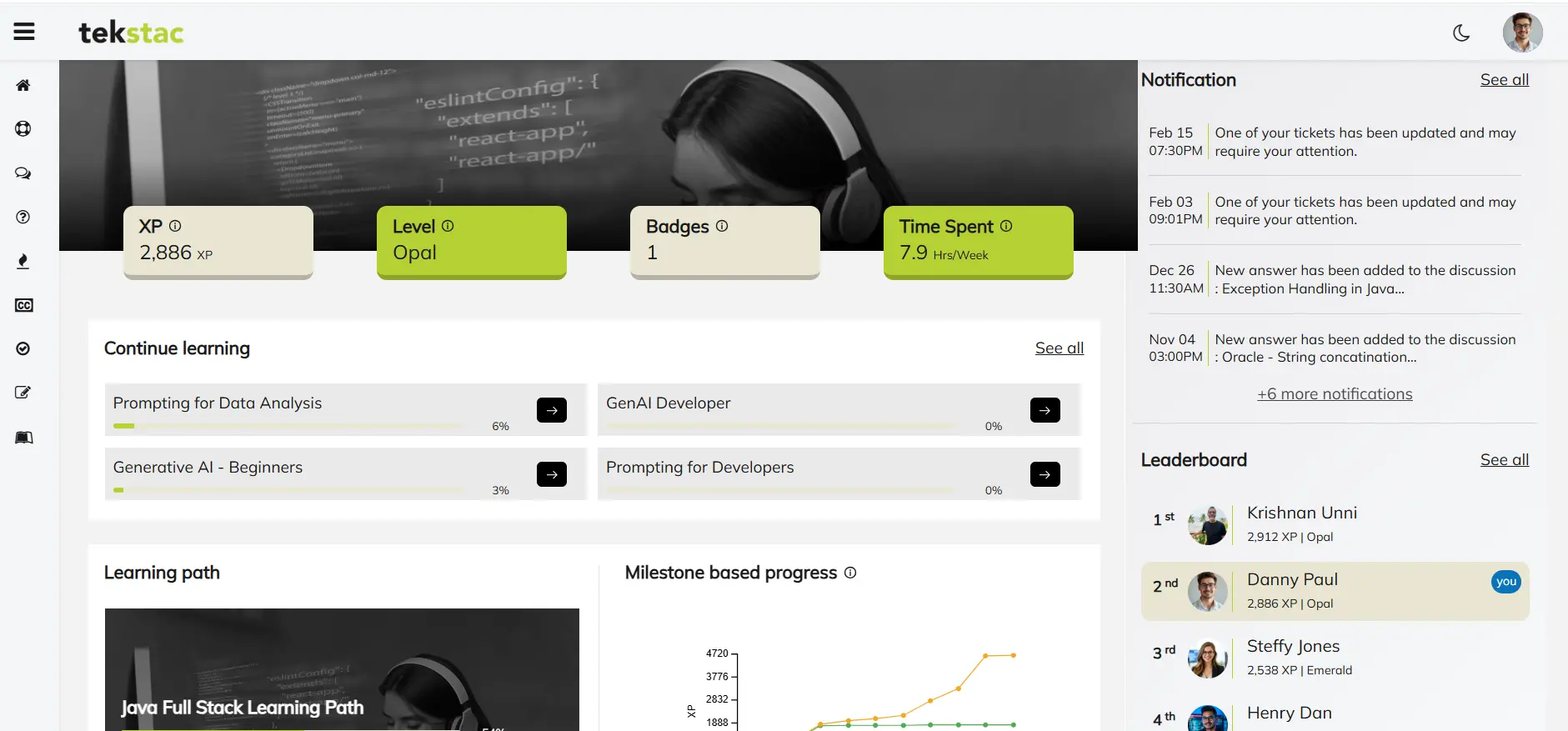
Why Tekstac Is the Best Course Building Platform for Enterprises
Investing in the right upskilling platform is a strategic decision that impacts workforce capabilities, organizational efficiency, and business growth. Tekstac stands out as a cutting-edge platform that offers:
- End-to-End Skill Lifecycle Management– Personalized learning, hands-on practice, assessments, and analytics.
- Proctoring & AI-Driven Evaluations – Ensures assessment integrity with AI-based monitoring and automated grading.
- Role-Based Upskilling & Career Pathing– Aligns learning with industry-specific job roles and career progression.
- Enterprise-Grade Security & Compliance– Ensures data protection with SOC2 Type II compliance and ISO 27001 (2023) certification.
Whether you’re a Tech manager, corporate trainer, or learning and development leader, selecting the right platform ensures long-term success in building a highly skilled workforce.
Book a demo today and see the transformative power of our 360° upskilling platform!
FAQs on Course Building Platform
1. What is the best way to build a course?
The best way is by using a Course Building Platform that supports multimedia, assessments, and engagement features. This ensures structured learning and better learner outcomes.
2. How to structure an online course?
Start with clear objectives, divide lessons into modules, add interactive elements, and use assessments. A Course Building Platform helps organize and deliver content effectively.
3. Which is India’s largest learning platform?
India has several large learning platforms, but for enterprise-focused upskilling, Tekstac offers a scalable Course Building Platform designed to meet modern workforce development needs.
4. Which course platform is best?
The best course platform depends on your goals. A Course Building Platform with scalability, analytics, and security—like Tekstac—ensures effective learning delivery and long-term success.
The Unseen War for Invisible Capabilities: Why Skilling Is the Real AI Advantage
Skilling in AI is no longer just a learning initiative; it’s a business strategy. But the real differentiator won’t be who deploys AI first, but who learns to work with it best.
Yet as algorithms grow smarter, one truth remains constant: technology’s value depends on the people who wield it.
This blog explores how AI advantage takes shape, and how organizations are turning AI into an invisible yet powerful force for performance, driven not by code, but by capability.
What Defines the AI Advantage in Banking and Finance?
In banking and financial services, we often talk about the next wave of AI cutting-edge models, predictive analytics, conversational interfaces. Yet, the most consequential AI applications aren’t the flashy ones. They’re the invisible capabilities woven into the daily flow of risk management, compliance checks, and customer engagement decisions. These capabilities don’t call attention to themselves, but they quietly outmanoeuvre the competition by catching small signals of change and acting before anyone else.
How Does Workforce Skilling Create the Real AI Advantage?
Beneath the surface of this transformation lies a critical truth: no algorithm can deliver its full value unless people know how to use it. Tools can be copied or bought off the shelf, but a well-trained workforce—one that intuitively applies AI-driven insights at the right moment—is nearly impossible to replicate. This is where the real battle is being fought.
Why Is AI Advantage Critical in Fraud Detection and Security?
Take fraud detection as an example. Many banks invest in sophisticated models to flag suspicious transactions. But the difference between an automated alert and a decisive, pre-emptive intervention often comes down to human expertise. A fraud analyst who understands the nuances of emerging schemes can override or refine an AI recommendation, catching anomalies that a generic algorithm might miss. That analyst isn’t simply following a script; they’re applying domain knowledge and pattern recognition developed over time.
The same holds true for risk officers who rely on predictive analytics or AI-driven early warning systems or relationship managers who use AI cues to personalize outreach. The banks that stand apart are those whose employees can interpret these cues and turn them into action—before the competition even knows an opportunity or threat exists.

How Can Cross-Functional Collaboration Strengthen AI Advantage?
To build this level of skill, organizations need more than classroom training on “AI 101.” They require a cultural shift where continuous learning is embedded into everyone’s job. Instead of seeing AI as a black box, people need to understand how AI adoption takes place, how models are developed, and where they might fail.
A Deloitte survey found that 67% of high-performing companies cite a culture of continuous learning as the foundation of their AI success.
That means creating environments where it’s acceptable to question AI outputs, run parallel checks, and propose alternative theories.
One way to make this happen is to encourage cross-functional rotations: let a credit underwriter spend time with the data science team, or a compliance officer rotate through the fraud unit. When employees see how each part of the organization uses AI, they develop a richer mental model of both the tools and the risks involved. Over time, this cross-pollination makes room for human-AI collaboration that breaks down silos and unearths opportunities no single department could spot alone.
What Role Does Leadership Play in Sustaining AI Advantage?
Mentorship programs can further accelerate this process. A veteran risk analyst who has navigated multiple market cycles can coach younger colleagues on what subtle signals to watch for in AI-driven dashboards. That institutional wisdom, paired with cutting-edge analytics, becomes a powerful edge that can’t be copied by a competitor simply purchasing the same software.
At the leadership level, executives play a pivotal role in signaling the importance of AI governance and human oversight in AI decisions. Instead of treating models as the final word, they should champion the idea that AI augments, rather than replaces, professional judgment. When a compliance manager or relationship banker sees leaders regularly engage with AI outputs—asking tough questions, challenging assumptions, interpreting findings—they learn that curiosity and rigorous thinking aren’t just tolerated but actively encouraged.
How Do Invisible AI Capabilities Win the Competitive Battle?
Over time, these behaviors create a workforce that doesn’t passively accept predictions but proactively looks for gaps in the data, biases in the model, or new patterns of fraud. The result is an organization whose AI capabilities remain largely invisible to the outside world—there’s no flashy rollout, but the performance gains are undeniable.
Customers may notice fewer hiccups and a smoother experience, but they won’t see the invisible engine that keeps fraud at bay, compliance strong, and offerings finely tuned to their needs. Rivals, meanwhile, will struggle to pin down what makes this bank or insurer so consistently agile.
Why Is Workforce Skilling the Linchpin of AI Success?
In this new era, skilling is the linchpin of AI success—and the true source of AI advantage. Infact surprisingly. By 2027, 80% of the AI workforce will need reskilling; because let’s face it, coding skills alone won’t cut it anymore.
Traditional training programs and vendor-led implementations aren’t enough. True competitive advantage demands a workforce that thinks and reacts in concert with AI, forming a quietly unstoppable partnership. Whether it’s thwarting fraud attacks before they surface or reading subtle market cues that others overlook, the organizations that invest seriously in upskilling and cultural transformation will outpace those that treat AI as a technology project alone.
And that is the essence of the unseen war: the real battle lines are drawn around the workforce. As soon as you embed AI literacy and a questioning mindset into every level of your organization, you’ll find yourself not just meeting the market’s demands but predicting them—often before anyone else even knows those demands exist.
FAQs on AI Advantages
1. What are the advantages of AI?
AI offers a range of advantages that go beyond automation or cost savings. At its core, AI enhances how organizations detect change, make decisions, and deliver value.
2. How does workforce skilling enhance AI advantage?
Workforce skilling is what turns AI from a tool into a true differentiator. Technology can process data and make predictions—but it’s people who give those insights, meaning and momentum.
3. What is the golden rule of gaining AI advantage?
The golden rule of gaining AI advantage is simple: invest in people as much as in technology.
4. Can AI replace humans?
AI can replicate certain tasks—but it can’t replace human judgment, creativity, or context.
Stealth Skilling: Build Future-Ready Enterprise Capabilities
What Is Stealth Skilling and Why It Matters
Imagine walking into a room full of leaders, all discussing their generative AI strategies. Certifications, courses, and training programs dominate the conversation, and every organization is racing to close skills gaps. Yet, one company is silent, confident, and observably ahead—its capabilities are evident in its results, but the source of its success remains invisible.
What’s their secret? Stealth skilling: a deliberate strategy to build capabilities competitors can’t replicate or even detect until it’s too late.
In the generative AI era, the most critical skills aren’t taught in public classrooms or certification programs. They’re embedded deep into workflows, codified into systems, and honed silently in the shadows of innovation. For companies that understand this, the focus has shifted from reacting to today’s needs to creating future-proof capabilities. They’re not playing to catch up—they’re designing capabilities that will leave their competitors irrelevant.
From Gaps to Mastery: The Stealth Skilling Revolution
The traditional approach to workforce skilling is broken. Companies identify a gap, train their workforce, and deploy talent to fill it. But this endless cycle of identifying and closing gaps creates a perpetual lag. By the time a workforce catches up, the industry has already moved on.
1. How Stealth Skilling Flips the Paradigm
Stealth skilling flips this paradigm. It’s not about filling gaps; it’s about predicting and embedding future capabilities before they’re even needed. In 2024, while 75% of companies are adopting AI, only 35% of talent have received AI training in the last year (Randstad, 2024). This gap highlights why reactive training alone isn’t enough—organizations need a stealth approach to build future-ready capabilities.
Organizations at the forefront of this revolution are rethinking how knowledge is captured, applied, and scaled. For example, rather than training teams on reactive problem-solving, they’re automating expertise into systems that anticipate issues before they arise. This isn’t just operational efficiency; it’s strategic foresight.
2. Knowledge Management as the Cornerstone of Stealth Skilling
Take knowledge management as a cornerstone. In most companies, expertise is siloed, locked away in the minds of employees or scattered across disconnected systems. Stealth skilling demands a different approach: codify that expertise into AI systems so that it becomes institutional knowledge, always accessible and never lost. For a CXO, this means no more scrambling to replace expertise when key employees leave or retire. Instead, the knowledge evolves within AI systems, continuously refining itself.
Stealth Skilling: Building an Invisible Competitive Moat
The true strength of stealth skilling lies in its invisibility. These capabilities aren’t broadcasted in glossy training catalogues or LinkedIn updates. Instead, they manifest in quiet but transformative outcomes: faster decision-making, predictive insights, and processes that adapt autonomously to market changes. Competitors don’t see it happening until they’re already left behind.
Picture a company that embeds real-time signal detection into its decision-making workflows. While others are still analyzing lagging indicators, this company adjusts in real-time to weak market signals, capitalizing on opportunities or mitigating risks before anyone else notices. These capabilities are the result of deliberate, behind-the-scenes skilling investments—not in employees alone but in building the AI systems that augment them.
Unlike traditional skilling programs, stealth skilling isn’t about incremental improvements. It’s about creating a gap so wide that competitors can’t bridge it. By the time rivals notice, the playing field has already tilted irreversibly.
How CXOs Can Implement Stealth Skilling Successfully
Stealth skilling doesn’t just happen. It requires a mindset shift from leaders, particularly at the CXO level. The first step is recognizing that today’s most valuable capabilities aren’t reactive—they’re proactive. Leaders must identify processes critical to long-term differentiation and begin embedding expertise into systems, not just people.
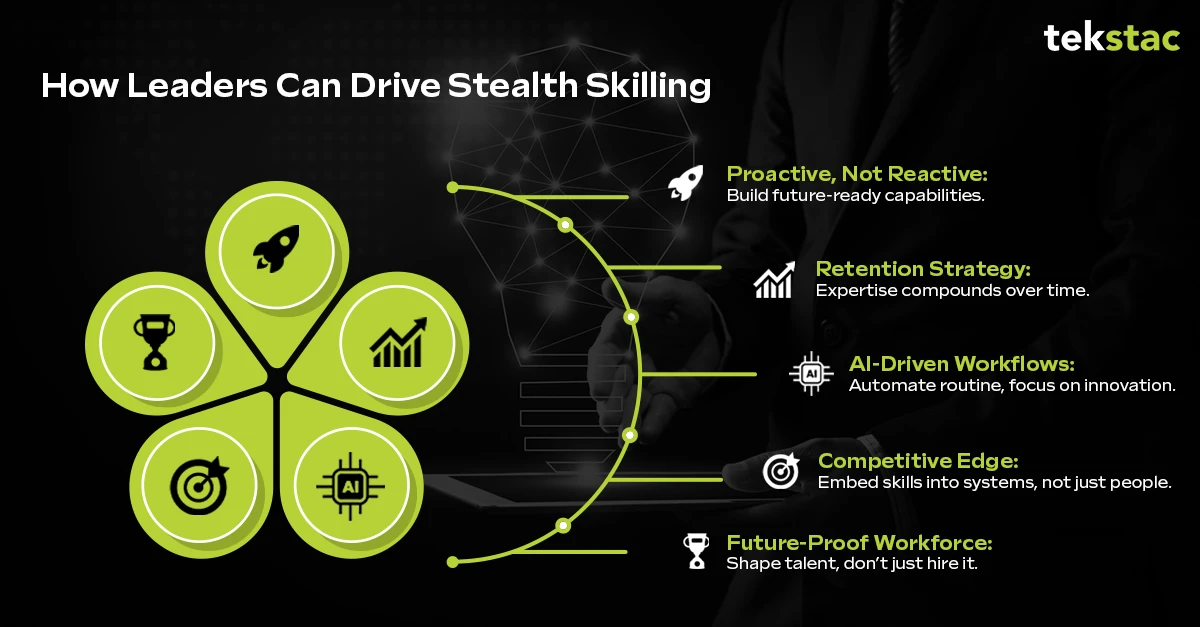
The focus should also extend to retention. Employees equipped with future-ready capabilities feel more engaged and aligned with the company’s vision. Retention isn’t just about reducing churn—it’s about building an ecosystem where expertise compounds over time, creating lasting competitive advantages. Moreover, as the war for talent intensifies, this approach signals to the market that your organization isn’t just hiring for today but shaping the workforce of tomorrow.
Operationally, this translates into investing in knowledge capture systems that scale expertise across teams. For instance, workflows that previously relied on manual judgment can be enhanced with AI-driven decision layers. The result? Teams can focus on innovation, while routine tasks are handled autonomously.
Why Stealth Skilling Is the Key to Future Competitive Advantage
In the world of generative AI, where visible strategies are quickly commoditized, stealth skilling is the competitive moat that can’t be breached. It ensures not just survival but dominance. By embedding expertise into AI systems, predicting skill needs before they arise, and continuously refining capabilities, organizations can stay ahead of market shifts and competitor plays.
For CXOs, the question isn’t whether to invest in stealth skilling—it’s how quickly they can implement it before others do. This is the difference between leading the AI race and being left behind in a game you never even realized was happening.
TL;DR:
Stealth Skilling embeds invisible, future-ready capabilities into workflows and AI systems, creating a competitive advantage that rivals can’t replicate. Organizations that implement it proactively stay ahead in the generative AI era.
FAQs on Stealth Skilling
1. How is stealth skilling different from traditional training?
Traditional training fills current skill gaps; stealth skilling predicts and builds capabilities proactively.
2. Why is stealth skilling important for enterprises?
It creates a competitive moat that is hard to replicate, enabling faster decisions and future-proof operations.
3. Who should lead stealth skilling initiatives?
CXOs and senior leaders should drive the strategy, embedding expertise into systems and aligning the workforce for long-term advantage.
4. What is a stealth strategy?
A stealth strategy is a business approach where initiatives, capabilities, or innovations are developed quietly to gain competitive advantage before others notice.
The Workforce Readiness Gap: Why Technology Alone Won’t Save You
Generative AI has rewritten the rules of competition. It’s no longer about whether you have the technology; it’s about whether you have teams that can use it effectively. Any company can buy AI tools, but not every company can be good at workforce capability building that elevates those tools into real business advantages. To address this workforce readiness gap, companies have to align employees with AI’s transformative capabilities and intensify their focus on upskilling and reskilling initiatives.
Why Is Workforce Readiness Key to Closing AI-Driven Skill Gaps?
But reacting to skill gaps after they appear just isn’t good enough anymore. In an environment where insights and automation can shift overnight, you need a predictive approach to skilling—one that equips your teams for today’s tasks and tomorrow’s unknowns. Businesses that get this right will lead in innovation; those that don’t will watch from the sidelines.
Why Is Reactive Skilling No Longer Enough in the AI Era?
For many years, skilling was a catch-up game: identify a gap, send employees to training, and hope they come back ready. But when AI can alter entire value chains at record speed, this model falls short.
Take, for example, a corporate L&D team that rolls out an AI-powered learning platform to personalize employee development. If managers and employees don’t know how to leverage it and how to interpret skill recommendations, track progress, or apply insights on the job, the platform’s potential is wasted.
The antidote is predictive skilling: using AI in workforce development and data-driven foresight to see what capabilities will matter next and starting to build them before they’re mission-critical. In fact, PwC’s 2025 AI Jobs Barometer finds that AI-exposed roles are evolving 66% faster than others, highlighting the urgent need to proactively upskill teams for emerging demands.
How Can You Measure Workforce Readiness and AI Skilling Success?
To measure whether your workforce is future-ready, consider the following five markers. Think of them as your “survival index” in the AI era:
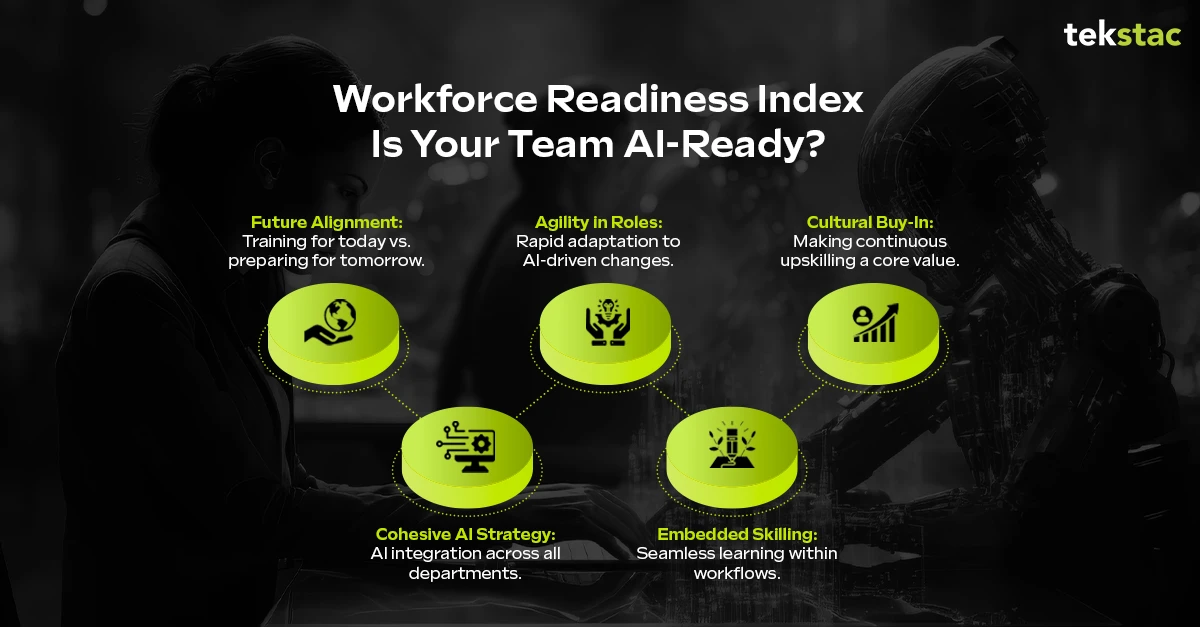
- Future Alignment – Are your training initiatives focused on current tasks, or are they anticipating emerging trends and technologies?
- Cohesive AI Strategy – Do teams across the organization—from HR to R&D—know how their roles contribute to your AI roadmap?
- Agility in Roles – How quickly can roles evolve when AI expands or shifts responsibilities?
- Embedded Skilling – Does learning happen naturally in the flow of work, or do employees have to shoehorn it into their schedules?
- Cultural Buy-In – Is ongoing skilling truly part of your company’s DNA, or just a buzzword?
Score low on any dimension, and you risk lagging behind companies that make skilling a constant, proactive discipline.
What Does the Shift from Static Jobs to AI-Infused Roles Mean for Employees?
In an AI-native organization, the boundaries of job roles blur. When machine-learning models provide real-time insights, employees must be ready to adapt on the fly. One consumer goods company, for instance, redefined its data analyst roles to include rapid experimentation with AI-driven product recommendations. The transformation led to more effective campaigns and faster decision-making—because teams were primed to pivot as soon as new insights surfaced.
To foster this kind of flexibility, leaders need to:
- Update job descriptions so they reflect ongoing collaboration with AI tools.
- Provide targeted, real-time training rather than relying on annual seminars.
- Make skilling part of daily workflows that extend beyond bridging the workforce readiness gap.
What Are the Key Workforce Readiness Strategies for CXOs in 2026?
- Adopt Continuous Skilling Ecosystems: Traditional courses can’t keep up with AI’s rapid evolution. Instead, invest in platforms and processes that deliver real-time, personalized learning paths.
- Focus on Collaborative AI Skills: People shouldn’t just understand AI technically; they need to integrate AI insights into problem-solving. Whether it’s marketing or supply chain management, the value comes from teams that mesh human creativity with machine-driven data.
- Prioritize Cultural Transformation: Even the smartest AI will fail if employees see it as a threat to their jobs. Make it clear that skill development is a top priority, champion it across every department, and reward those who embrace continuous learning.
What Are the Risks of Ignoring Workforce Readiness in the Age of AI?
Failing to skill up your teams isn’t just a missed opportunity—it’s a potential death sentence in today’s hyper-competitive market. Studies show that when AI projects underperform, the culprit is often a workforce that isn’t equipped to interpret and apply AI outputs effectively. You can deploy all the cutting-edge tools you want, but without AI-ready talent, your investments remain underutilized, your results underwhelming.
At the end of the day, technology alone won’t save you. The true differentiator is a workforce that knows how to harness AI in a way that drives real, measurable impact. And as AI continues to evolve, so must your approach to skilling. The question isn’t whether you need to do this; it’s whether you’ll do it fast enough to stay relevant.
FAQs on Workforce Readiness
1. What does workplace readiness mean?
Workplace readiness refers to a skilled generation of leaders who have the knowledge, skills and abilities required to carry out a series of professional tasks.
2. How do you measure workforce readiness?
Workforce readiness goes beyond skill completion rates or training hours. You can measure it across three dimensions:
- Skill Readiness: How well employees’ current skills align with emerging roles.
- Change Readiness: How quickly teams can adapt to new tools, systems, or strategies.
- Performance Readiness: How effectively employees can apply learning on the job.
3. Why is workforce readiness important for AI adoption?
Workforce readiness is crucial for AI adoption because employees need the right skills, mindset, and adaptability to effectively use AI tools and translate them into real business impact.
4. How are U.S. enterprises addressing the workforce readiness gap?
U.S. enterprises are tackling the workforce readiness gap by building AI and digital skills through targeted training and education partnerships. They’re prioritizing upskilling over replacement, using data and skill analytics to spot gaps early, and embedding AI adoption into everyday work. Many are also shifting to skills-based hiring and creating new career pathways to stay future-ready.
Predictive Skilling: Closing Skill Gaps Before They Begin
For years, companies have tackled workforce development like plugging holes in a sinking ship—spot a problem, run some training sessions, and hope it’s enough to keep you afloat. In a world shaped by Generative AI, that skilling model isn’t just outdated—it’s risky.
This is where Predictive Skilling comes in. By combining predictive analytics with workforce skilling, organizations forecast future capability needs before gaps appear. This proactive ecosystem ensures employees aren’t only trained for today—but fully prepared for tomorrow’s AI-driven market shifts. Skill gaps aren’t shrinking; they’re multiplying. While AI capabilities race ahead, organizations playing “catch-up” only fall further behind.
Predictive Skilling: Preparing Your Workforce for the Future of Work
A handful of forward-thinking businesses have stopped trying to “patch gaps” altogether. Instead of reacting to skill deficiencies after the fact, they’re predicting future needs and training for them before they become urgent. This approach is all about predictive skilling ecosystems, which leverage generative AI to ensure employees aren’t just ready for the present—they’re primed for whatever the market demands next. Platforms like Outskill AI are helping organizations implement these predictive learning strategies effectively.
Why Reactive Training Fails in the Age of AI and Predictive Analytics
Traditional thinking assumes you can identify skill shortages, run a training program, and magically achieve alignment with business goals. This might have worked when industries moved at a slower pace. But when markets can pivot overnight, by the time you’ve identified one shortfall, the industry’s already shifted again.
A global logistics giant in 2025 found this out the hard way. After investing millions in retraining employees to use AI optimization tools, they discovered that competitors had already adopted generative AI to predict demand fluctuations in real time. By the time the giant’s employees were fully trained, it had lost critical market share to nimbler rivals.
The lesson is pretty stark: unless you can skill at the speed of business, you risk stagnating. Generative AI now offers a way to anticipate and fill skills before they become bottlenecks.
According to the World Economic Forum, by 2025, 50% of employees will need reskilling due to rapid technology adoption and automation.
From Skill Gaps to Predictive Skilling Ecosystems
Predictive skilling ecosystems, powered by generative AI, flip the entire paradigm. Instead of frantically closing gaps, they aim to keep gaps from forming in the first place. Here’s how they do it:
- Foresight, Not Hindsight: AI analyzes your workforce capabilities, upcoming tech shifts, and emerging market demands. It then forecasts the skills your people will need in the next 6 to 24 months.
- Personalized Learning Paths: Each employee gets a growth map tailored to both current responsibilities and future roles they’re likely to step into.
- Ongoing Updates: As the market changes, so do these skilling programs. They adapt in real time, ensuring that development plans stay relevant and employees stay ahead of the curve.
Real-World Impact: How Predictive Analytics Transforms Enterprises
A multinational insurance company made headlines in 2024 by rolling out a predictive skilling ecosystem. Instead of anxiously watching rivals, they chose to be proactive. They spotted that AI would soon reshape underwriting, so they used generative AI to build specialized learning paths for their underwriters—teaching them to interpret AI-generated risk models and make quicker, more accurate decisions.
Within a year, claims-processing times fell by 40%, and underwriting accuracy soared. But the true power lay in how this approach kept evolving. Even as AI technologies advanced, their workforce advanced too, widening a competitive gap that competing insurers struggled to close.
Building Predictive Skilling Ecosystems with Generative AI
Shifting to a predictive model isn’t a snap of the fingers, but it is essential. Here are the core steps:
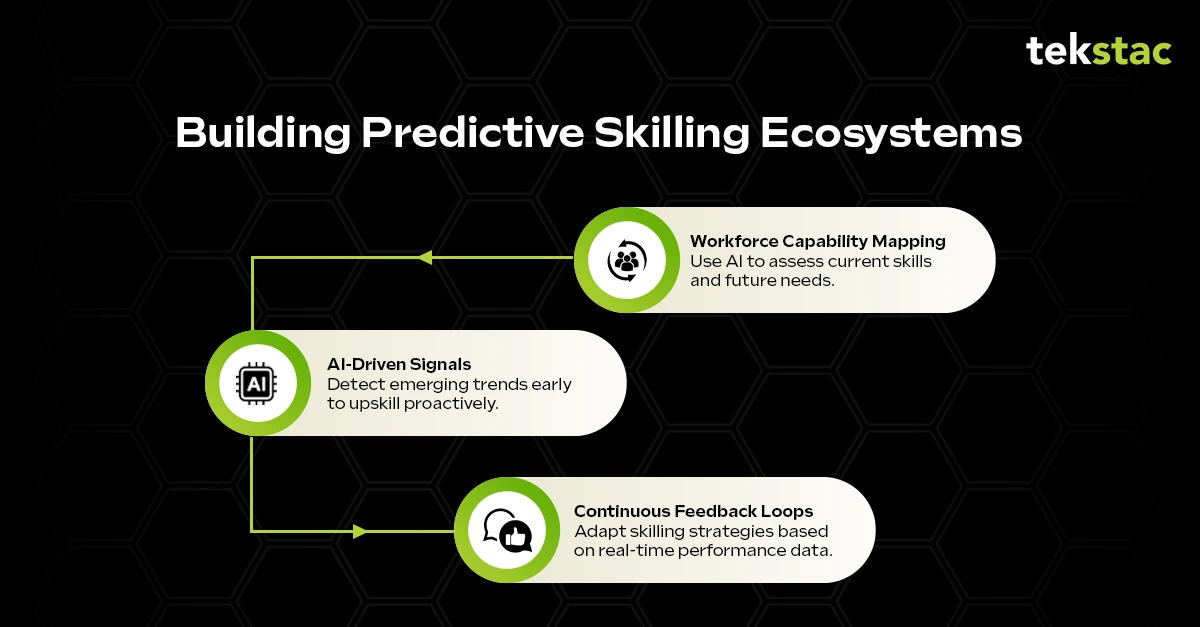
- Workforce Capability Mapping: Use AI tools to create a real-time snapshot of your current workforce skills, matched against your future needs.
- AI-Driven Signals: Rather than waiting for a crisis, let AI alert you to emerging technologies or market trends so you can train your people before those skills become must-have.
- Continuous Feedback Loops: As results roll in—from KPIs to employee performance—keep refining your skilling priorities and methods. Generative AI adapts as you learn.
Companies that master this process aren’t just investing in employees; they’re making sure the organization remains vital, no matter how fast the market pivots.
What Business Leaders Need to Know About Predictive Skills
For Chief Transformation Officers, Chief Learning Officers, and any C-suite leader, the path is clear: move beyond outdated skilling platforms and embrace predictive ecosystems. The cost of waiting is huge—lost opportunities, stunted growth, and slipping market position. In contrast, the payoff for acting now can be nothing short of transformational.
Predictive skilling doesn’t just help your workforce keep up; it aligns people strategy with business strategy, ensuring that you’re prepared for tomorrow’s challenges. Once you stop chasing skills and start defining the future, you’ll find you’re no longer patching holes—you’re sailing ahead of the storm.
FAQs on Predictive Skilling
1. What is the difference between predictive analytics and forecasting?
Predictive analytics uses real-time data and AI models like random forests and gradient boosting to reveal which skills an organization will need next and who should develop them, while forecasting relies mostly on past patterns to project trends. Predictive analytics goes further by offering actionable guidance, making it far more effective for preparing talent instead of reacting after gaps form.
2. Which skills are most valuable for the next 10 years?
Skills like AI literacy, data analytics, critical thinking, adaptability, and digital collaboration will stay essential as technology evolves. AI models such as large language models and clustering algorithms help organizations identify which of these capabilities are most relevant for their roles. These future-ready skills allow employees to stay aligned with rapidly changing business needs.
3. How to use predictive modeling to avoid workforce skill gaps?
Predictive modeling uses algorithms such as ARIMA, transformers, and pattern-matching models to compare current workforce capabilities with emerging job and technology trends. By spotting gaps before they appear, organizations can launch training programs early instead of reacting after performance issues surface. This proactive approach strengthens continuity and reduces skill-related risk.
4. How does predictive skilling improve workforce readiness?
Predictive skilling applies recommendation models and skill-graph algorithms to map current employee strengths against future demands and pinpoint who needs which skills next. This enables targeted learning paths that keep talent development aligned with organizational change. As a result, the workforce stays ready as transformation unfolds rather than trying to catch up later.

